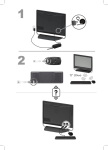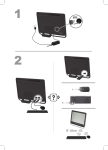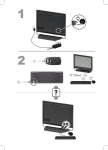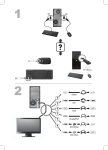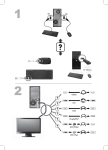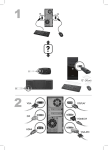Download HP 18 18-1300l
Transcript
Copyright and License © Copyright 2011 Hewlett-Packard Development Company, L.P. The information contained herein is subject to change without notice. The only warranties for Hewlett-Packard products and services are set forth in the express statements accompanying such products and services. Nothing herein should be construed as constituting an additional warranty. HP shall not be liable for technical or editorial errors or omissions contained herein. HP assumes no responsibility for the use or reliability of its software on equipment that is not furnished by HP. This document contains proprietary information that is protected by copyright. No part of this document may be photocopied, reproduced, or translated to another language without the prior written consent of HP. Hewlett-Packard Company P.O. Box 4010 Cupertino, CA 95015-4010 USA This product incorporates copyright protection technology that is protected by U.S. patents and other intellectual property rights. Use of this copyright protection technology must be authorized by Macrovision, and is intended for home and other limited viewing uses only unless otherwise authorized by Macrovision. Reverse engineering or disassembly is prohibited. Microsoft and Windows are trademarks of Microsoft Corporation in the U.S. and other countries. HP supports lawful use of technology and does not endorse or encourage the use of our products for purposes other than those permitted by copyright law. The information in this document is subject to change without notice. Warranty Print on Demand Statement You can find the expressly provided HP Limited Warranty applicable to your product in the start menu on your PC and/or in the CD/DVD provided in the box. For some countries/regions, a printed HP Limited Warranty is provided in the box. In countries/regions where the warranty is not provided in printed format, you may request a printed copy from hp.com/go/orderdocuments or write to HP at: Hewlett-Packard, MS POD, 11311 Chinden Blvd., Boise, ID 83714, U.S.A.; Hewlett Packard, POD, P.O. Box 200, Alexandra Post Office, Singapore 911507. Please include your product name, warranty period, name, and postal address. 1 Getting information Type of information Where to find ● Set up your computer. Quick Setup (this Guide) ● Use the computer. Quick Setup (this Guide) ● Connect to the Internet. ● See how-to videos about using Visit http://www.hp.com/supportvideos (English only) the features of your computer. ● Find electronic user guides HP Support website: http://www.hp.com/support and specifications for your computer model. ● Order parts and find additional troubleshooting help. ● ● Upgrade or replace Upgrading and Servicing Guide components of your computer. HP Support website: http://www.hp.com/support Find computer warranty Limited Warranty and Support Guide or the Warranty and Support information. Information included with your computer. ● Get technical support. ● Get up-to-date information and http://www.hp.com/support/consumer-forum help from the Windows community. ● Find safety and regulatory Safety & Regulatory Information notices. ● Find ergonomic information. ENWW Safety & Comfort Guide 1 2 Setting up your computer WARNING! To reduce the risk of electrical shock or damage to your equipment: • Place the computer in a location away from water, dust, moisture, and soot. These can increase the inside temperature, or can cause fire or electrocution. • Do not disable the power cord grounding plug. The grounding plug is an important safety feature. • Plug the power cord in a grounded (earthed) outlet that is easily accessible at all times. • Disconnect power from the equipment by unplugging the power cord from the electrical outlet. To prevent direct exposure to laser beam, do not try to open the enclosure of the CD or DVD drives. • The power supply is preset for the country/region in which you purchased your computer. If you move, check the voltage requirements for your new location before plugging the computer into an AC power outlet. The computer may be heavy; be sure to use ergonomically correct lifting procedures when moving the computer. To reduce the risk of serious injury read the Safety & Comfort Guide. The guide is located on the web at http://www.hp.com/ergo. 1. Place the computer so that all ventilation openings are unobstructed and cabling is not in a walkway or where it can be stepped on or damaged by placing furniture on it. 2. Connect all power cords from the monitor, computer, and accessories to a power surge protection device that is specifically labeled as having surge protection, an uninterruptible power supply (UPS), or a similar device. If the computer has a television tuner, or a modem or telephone connection, protect the computer by using surge protection with these signal inputs as well. Connect the television cable or the telephone line cord to the surge protection device, and then connect the device to the computer. 3. Read the Safety and Regulatory Information document that is found on your product CD. 4. Read the Safety & Comfort Guide for proper workstation setup, posture, health and work habits, and electrical and mechanical safety information. This guide is found on your product CD. NOTE: Use only licensed original software. Installing copied software could result in an unstable installation, infect the computer with a virus, or be illegal. Security solutions can deter theft, mishandling, and software attacks, but cannot prevent them. 2 Chapter 2 Setting up your computer ENWW Connecting to the Internet Steps to connect to the Internet: 1. Connect the hardware as shown on the setup view. 2. Get Internet service. ● 3. Sign up with an Internet Service Provider (ISP). If you already have an account with an ISP, skip this step and follow the instructions provided by the ISP. Using your Internet connection through your ISP, open a web browser and browse the Internet. NOTE: If you have issues connecting to the Internet, see Internet access on page 11. ENWW Connecting to the Internet 3 3 Setting up additional features Using an HDMI monitor (select models only) If your computer has a graphics card with an HDMI (High Definition Multimedia Interface) connector, Hewlett-Packard recommends using a DVI or VGA connector for a monitor, and using HDMI to connect a TV. If you use HDMI to connect your monitor, you may need to adjust some settings to hear sound. Because of this, HP recommends that you connect analog speakers to the computer if you want to hear sound during the initial setup of the computer. For optimum viewing, you may need to adjust the resolution setting for the monitor. NOTE: If you ever need to recover the computer operating system you may need to activate sound and adjust resolution for the HDMI connector. IMPORTANT: Your HDMI monitor must be connected to the graphics card before you activate sound and adjust resolution. Using the HDMI port controls (select models only) The right side of your computer may contain an HDMI port and volume control buttons. Unless a device is plugged into the HDMI port, the volume controls have no functionality. The HDMI controls are only intended to control the settings of the device plugged into that port, and do not control any other media devices on the system. To use the HDMI port controls, plug a device into the HDMI port. Press the menu button (the top button displayed). A new on-screen menu displays. Using the +/buttons, select brightness, volume, contrast, or color balance. When a device is plugged into the HDMI port, the volume on the computer is muted. Pressing the +/- buttons on the side panel does not change the volume of the computer. 4 Chapter 3 Setting up additional features ENWW 4 Maintaining your computer Cleaning procedures Keeping your computer system free of dust, dirt, and heat will prolong its life. ● Dust, pet hair, and other particles can build up, creating a blanket effect; as a result, components can overheat or, in the case of the keyboard and mouse, not work smoothly and effectively. ● Check your system once a month for visible signs of dust and debris, and clean it about once every three months. ● Visit www.hp.com/support for additional cleaning instructions. Cleaning the computer Air vents keep the computer cool. Keep these vents clean by using a small, battery- vents powered vacuum cleaner. (A battery-powered vacuum cleaner eliminates the risk of electric shock.) 1. Vacuum the vents on the computer case. 2. Remove any debris that has accumulated in and around the computer connectors (for example, the Ethernet and USB connectors). ENWW Cleaning procedures 5 Cleaning the keyboard and When cleaning the keyboard keys, use a low setting on a battery-powered vacuum mouse cleaner, to avoid removing key caps and springs. 1. Vacuum between the keys of the keyboard and along the grooves. 2. Use a clean, dry cloth and isopropyl (rubbing) alcohol to clean buildup on the keyboard keys and along its edges. 3. Wipe the body of the mouse and the mouse cord by using cleaning wipes. If you have a roller-ball mouse, clean the ball and rollers inside: 1. Turn the mouse upside down, and rotate the ball-cover ring counterclockwise to remove the ring and release the roller ball. 2. Rinse the roller ball with soap and warm water. 3. Clean the rollers inside the mouse with a cotton swab dampened with isopropyl (rubbing) alcohol. 4. After the roller ball and rollers are completely dry, replace the ball and ballcover ring. Cleaning the touch screen Follow these steps to clean the touch screen: (AiO models only) 1. Turn off the computer. Tap the Start button, and then tap Shut Down. 2. Disconnect the power cord from the wall. 3. Spray a small amount of mild glass cleaner on a soft cloth to clean the touch screen. 4. Wipe the surface and left and right side of the touch screen to remove any dirt, fingerprints, or other debris that could hinder the touch recognition of the screen. CAUTION: Do not spray or place the cleaner directly on the screen; spray the cleaner into the cloth, and then wipe the sides and surface of the touch screen. Do not use an abrasive cleaner or cloth when cleaning the sides or the surface of the screen, because this could cause damage to the touch screen. 6 Chapter 4 Maintaining your computer ENWW 5 Troubleshooting Refer to the documentation provided by the product manufacturer for information about peripheral-specific problems, such as issues with a monitor or a printer. The following tables present some issues you might encounter while installing, starting up, or using your computer and possible solutions. For more information or for additional troubleshooting options, see Getting information on page 1. Computer does not start Symptom Possible solution Error message: Restart the computer. Hard disk drive 1. Press the Ctrl+Alt+Delete keys on the keyboard simultaneously. 2. Press and hold the Power button on the computer for 5 or more seconds to turn off the error. computer, and then press the Power button to restart the computer. 3. Contact Support, whether it was possible or not to start up Windows. Either the hard disk drive or the system board may need to be replaced. Computer will Ensure that the cables connecting the computer to the external power source are plugged in not turn on or properly. When the cables connecting the computer to the external power source are plugged start. in properly, and the wall outlet is functioning, the green power supply light on the back of the computer should be on; if it is not, contact Support. If the display (monitor) is blank, the monitor might not be properly connected. Connect the monitor to the computer, plug it in, and turn it on. See Display (monitor – select models only) on page 8. Test the wall outlet by connecting a different electrical device to it. Error message: When drive activity stops, remove the disc and press the spacebar on the keyboard. The Invalid system computer should start up. disk or NonSystem disk or Disk error. ENWW Computer does not start 7 Power Symptom Possible solution Computer does Press and hold the Power button until the computer turns off. Check Power Settings. not turn off when the Power button is pressed. Computer shuts ● down ● automatically. The computer might be in an exceedingly hot environment. Let it cool down. Ensure that computer air vents are not blocked and that the internal fan is running — see : Cleaning procedures on page 5. (Your computer might not have an internal fan.) Display (monitor – select models only) Symptom Possible solution Screen is blank, and Reconnect the power plug to the back of the monitor and to the wall outlet. monitor power light is not lit. Press the Power button on the monitor. Screen is blank. Press the space bar on the keyboard or move the mouse to make the screen display visible again. Press the Sleep button (select models only), or Esc on the keyboard, to resume from Sleep mode. Press the Power button to turn on the computer. Inspect the monitor video connector for bent pins: 8 ● If any of the pins are bent, replace the monitor connector cable. ● If no pins are bent, reconnect the monitor connector cable to the computer. Chapter 5 Troubleshooting ENWW Keyboard and mouse (general) Symptom Possible solution Keyboard Use the mouse to turn off the computer, unplug and reconnect the keyboard to the back of commands and your computer, and then restart your computer. typing are not recognized by the computer. Mouse (with cable) does not work or is not detected. Unplug and reconnect the mouse cable to your computer. If the mouse is still not detected, turn off the computer, unplug and reconnect the mouse cable, and then restart the computer. Cursor does not Press Num Lock on the keyboard to turn off Num Lock, so that the arrow keys on the move using the number keypad can be used. arrow keys on the number keypad. ENWW Keyboard and mouse (general) 9 Keyboard and mouse (wireless) Symptom Possible solution Wireless keyboard ● Ensure that you are using the wireless keyboard or wireless mouse within range of the or mouse does not receiver, approximately 10 meters (32 feet) for normal use, and within 30 cm (12 work or is not inches) during initial setup or for re-synchronization. detected. ● Ensure that the mouse is not in Suspend mode, which occurs after 20 minutes of inactivity. Click the left mouse button to reactivate it. ● Replace the batteries in the keyboard and mouse. ● Re-synchronize the keyboard and mouse to the receiver using the following steps. The receiver, wireless keyboard, and wireless mouse shown in the following illustrations are examples; your models might vary. IMPORTANT: During these steps, place the wireless keyboard and wireless mouse on the same level as the receiver, within 30 cm (12 inches) of the receiver, and away from interference from other devices. 1. Unplug the receiver from a USB connector on the computer, and then reconnect it. Your computer model might have a connector dedicated to the receiver. If you have a choice, use a USB connector on the front of the computer. 2. Check that the mouse is on (A), and push and hold the Connect button (B) on the underside of the mouse for 5 to 10 seconds until the LED on the receiver lights or stops flashing. The receiver connection session times out after 60 seconds. To ensure that the connection was established, and that the receiver did not time out instead, move the mouse and check for response on the screen. A 3. Off B Connect On After the mouse connection is established, continue by using the steps that follow to repeat the procedure for the keyboard. 4. Push and hold the Connect button (C) on the underside of the keyboard for 5 to 10 seconds until the LED on the receiver lights or stops flashing. C 10 Chapter 5 Troubleshooting ENWW Speakers and sound Symptom Possible solution If you use an High-Definition Multimedia Interface (HDMI) connector on the graphics card (select models only) to connect your monitor to the computer, you should also connect analog speakers to the computer Audio Line Out connector if you want to hear sound during the initial setup of the computer. Refer to the Setup Poster to connect analog speakers. If you are using built-in monitor speakers, use the monitor front-panel Volume button to adjust volume. Use the front-panel buttons to enter the on-screen display (OSD) and ensure that audio is enabled and that the volume is set appropriately. Ensure that you connected powered (active) speakers and that they are turned on. Turn off your computer, and then unplug and reconnect the speakers. Ensure that the speakers are connected to an audio connector, not a Line In or headphone connector. To resume from Sleep mode, press the Sleep button (select models only), or press Esc. Unplug headphones if they are connected to your computer (or speaker system). Volume is very low Ensure that you connected the speakers to the Audio Out (lime green) connector on the or unsatisfactory. back of the computer. (Additional audio connectors are used for multiple-channel speakers.) Detached non-powered speakers (speakers without a separate power source, such as batteries or a power cord) do not produce satisfactory sound. Replace the nonpowered speakers with powered speakers. Internet access Symptom Possible solution Internet programs do Log in to your ISP, and start the desired program. not start automatically. ENWW Speakers and sound 11 Symptom Possible solution I cannot connect to Verify that you are using the proper cables for your Internet connection type. Your the Internet. computer might have a dial-up modem and an Ethernet network adapter (also called a network interface card, or NIC). A modem uses a standard telephone cable, whereas the network adapter uses a network cable, to connect to a local area network (LAN). Do not connect a telephone cable to the network adapter, and do not plug a network cable into a telephone service line; doing so might damage the network adapter. If your system has an external antenna, try to move the antenna to a better position. If the antenna is internal, try to move the computer. Try to connect again later, or contact your Internet service provider (ISP) for assistance. Software troubleshooting To repair ● software problems, try these methods: Turn the computer off completely and then turn it on again. This is the easiest (and sometimes the best) way. ● Reinstall the software program or hardware driver (see Software program and hardware driver reinstallation, later in this table). — Restores the software (if it came with the product) or hardware driver to factory defaults. ● System Recovery (see Troubleshooting and Maintenance Guide on your product CD. Erase and reformat the hard disk drive, and then reinstall the operating system, programs, and drivers. This erases all data files you have created. Software If any of your factory-installed software programs or hardware drivers are damaged, you can program and reinstall it by using the Recovery Manager program (select models only). hardware driver reinstallation NOTE: Reinstall any programs, that came on CDs or DVDs included in the computer box, directly from the CDs or DVDs. Before you uninstall a program, be sure you have a way to reinstall it. Check to be sure that it is still available from where you initially installed it (for example, discs or the Internet). Or check to be sure that the program is in the list of programs you can reinstall from the Recovery Manager. 12 Chapter 5 Troubleshooting ENWW 6 Support information Ways to get help Easy to reach. Easy to use. Award-winning HP Customer Support is our promise to help you get the most from your computer. Whether with tools located on your computer, from information on the web, by phone, or through your local retailer, you’ll find what you need. Before contacting the HP Customer Care Center, it’s important to have the following information handy. ● Model number ● System (product) number ● Serial number ● Software build number ● Operating system ● Purchase date Please take a moment to write down your product information for future reference. The first four items on the list (model number, product number, serial number, and software build number) can be viewed by pressing the Ctrl+Alt+S keys on the keyboard at the same time. Don’t forget to register! Go to: http://www.hp.com/apac/register. Where to get help For help online, go to the HP Customer Care Center website at http://www.hp.com/support. Phone assistance to get you up and running is covered for thirty (30) days from the time you purchased your computer. After thirty (30) days, there may be a charge, but the helpful support is still available. Customer support for repairs If your computer needs to be repaired or to have parts replaced, you have two choices: ENWW ● You can easily replace many of your computer parts that are considered consumer replaceable. This is the fastest method of repair, as many times we can send the part directly to your home or business in a few days. ● If a repair is necessary, the HP Customer Care Center will make arrangements to fix your computer. Ways to get help 13 These services are covered during the warranty period. There are a few limitations and exclusions to the warranty (as well as some important details), which are described in the Hardware Limited Warranty section of the Limited Warranty and Support Guide. Before upgrading your hardware Any hardware upgrades that you intend to do should only be done after you have completely set up your new computer. Refer to the setup poster included with your system for help with setting up. If you have any problems setting up your system and turning it on, immediately contact the HP Customer Care Center listed earlier in this guide, and a HP Customer Representative will assist you. This must be done first before attempting to upgrade your system. By breaking the security seal on the back of the computer, you are confirming that the computer was working properly before you attempted to upgrade your system. Once the security seal has been broken, your computer is then, to the extent allowed by local law, covered under the terms and conditions listed in the Hardware Limited Warranty section of the Limited Warranty and Support Guide. 14 Chapter 6 Support information ENWW The power to make a change Thank you for your purchase. HP is dedicated to producing the highest quality, best performing, and easiest to use computers in the world. HP also designed this product with the environment in mind. But to reduce its impact even further, we need your help. Let’s work together to make a change. How you can help What we do Recycle your old computer. We design with the environment in mind. Disposing of electronic waste responsibly has been an HP priority for more than 20 years. If this computer is a replacement for an older computer you no longer need, go to www.hp.com/go/recycle to find out if HP can help you dispose of your old computer with minimum impact on the planet. While we want you to enjoy this computer for many years to come, we recognize that you will eventually dispose of it. We have designed it so it can be easily dismantled and recycled as much as possible. The packaging that came with your computer is also designed for maximum recyclability. Don't use a screen saver. We design to be more energy efficient. Screen savers can prevent your HP computer from going to sleep and thereby waste power. Screen savers can also reduce the life of your monitor by increasing the number of hours the LCD backlight is on. This computer has HP Power Management Technology, which can reduce computer energy use up to 45% compared to computers without power management. HP computers keep energy needs to a minimum, saving you money and reducing your carbon footprint. Don't disable the power settings. We design our products to use better and fewer materials. The power management tools on this computer are set to minimize energy use without impacting performance. Please do not disable them. Printed in Ensuring the health of you, your family, and our planet is a key priority at HP. We are committed to using the safest materials in the production of this and all our other products.




















